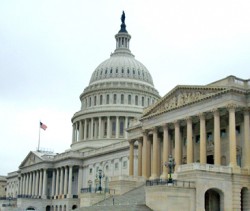Dombeck’s Legacy Deserves
We all knew it was coming, but last month’s letter of resignation from Forest Service Chief Mike Dombeck still caused worry and woe for those of us who care about protecting wild forests. Dombeck’s departure marks the end of an unprecedented period of agency reform and the start of the Bush administration’s assault on public forests.
In his four years in office, Dombeck led a virtual revolution within the U.S. Forest Service, an agency long known for putting timber values above the ecological and recreational needs of the American public. A fisheries biologist by training, Dombeck saw the imbalances caused by the agency’s institutional bias towards logging and sought to fix them.
He refocused agency budgets and personnel on the other “multiple uses” the Forest Service was supposed to be emphasizing, such as protecting watersheds that provide drinking water to 60 million Americans, managing 35 million acres of wilderness land, and maintaining 23,000 recreational sites.
“Too often in the past we have looked at resources in a single way,” Dombeck told an Asheville audience in 1999. “If ecosystem management has taught us anything, it’s taught us that everything is connected and our communities, our economies, the ecological health of the landscape is all intertwined.” He urged his employees to focus on the health of the land first, commodity production second.
But Dombeck’s greatest accomplishment was the Roadless Area Conservation Rule, an administrative policy that would protect 58.5 million acres of unspoiled, publicly owned forest from road-building and logging. Wildly popular with the public (1.6 million people commented in favor of the rule), the policy nonetheless came under fire from western Republicans beholden to the timber industry.
Dombeck stayed the course, however, and — even more remarkably — managed to keep his notoriously spineless boss, Bill Clinton, from giving in to the vocal minority of loggers, off-road vehicle nuts, and politicians who opposed the rule. After three grueling years of public and congressional debate, the policy to safeguard our last wild, roadless lands was officially published in the Federal Register in the final days of the Clinton administration.
It didn’t stay policy for long, however. Under the guise of “reviewing” the rule, the Bush administration arbitrarily put the policy on hold until May 12, two months after it was due to go into effect. Bush officials were stalling for time to find a way to rescind or water down the policy, and their strategy worked. Timber giant Boise Cascade and the State of Idaho filed a lawsuit to overturn the policy, and this month a federal judge overseeing the case declared that the rule was “illegally written” because it was “drafted without adequate public comment.”
The judge’s findings are baffling given the 18 months of studies and 600 public hearings preceding the final policy, but his ruling offers the Bush administration an easy way out. Up until now, the administration has refused to defend the policy in court (despite Attorney General John Ashcroft’s pledge to do so during his confirmation hearings). Now all they have to do is settle with Boise Cascade and Idaho, agreeing to drop or significantly weaken the rule.
Dombeck saw this coming, and in his resignation letter, urged Agriculture Secretary Ann Veneman to withstand the timber industry’s political pressure. “I hope the Administration’s intent is not to negotiate a settlement with those opposed to roadless area protection,” he wrote. “Doing so would undermine the most extensive multi-year environmental analysis in history.”
He pointed out that “not a single private land owner or corporate interest would continue to build new roads in pristine areas while saddled with a crumbling 386,000 mile road system with an $8.4 billion road maintenance backlog liability.” Besides, Dombeck said, the policy affects only “one quarter of one percent of our nation’s timber and a fraction of a fraction of our oil and gas.”
But Dombeck’s advice may fall on deaf ears, given the Bush administration’s continued regression towards the days of Interior Secretary James Watt. Just last month, Bush nominated J. Steven Griles to serve as Deputy Secretary of Interior. Griles is currently a lobbyist for the National Mining Association and he served under Watt in the 1980s. Like Interior Secretary Gale Norton, he supports increased extraction of timber and minerals from public lands.
Just as the Voice was going to press, the Bush administration appointed Dale Bosworth, a career USFS employee, to be Dombeck’s successor. Bosworth comes to his new job from the timber-production end of the spectrum. He started as a forester in Idaho’s St Joe National Forest and has served as regional forester for the Forest Service’s Northern Region (which includes Idaho and Montana), one of the agency’s big timber producing areas. It should come as no surprise if Mr. Bosworth seeks to overturn many of the reforms Dombeck began in his tenure.
If George W. Bush was a true conservative, instead of a toady for corporate oil, gas, and timber interests, he would protect all national forest lands from logging and road-building. In March, the Forest Service reported that their timber sale program lost $126 million in 1998, $38 million more than they lost the previous year. Protecting roadless areas wouldn’t end this form of corporate welfare, but it would help save taxpayers millions of wasted dollars spent on road-building in steep, sensitive terrain.
Related Articles
Latest News

Leave a comment
Your email address will not be published. Required fields are marked *




